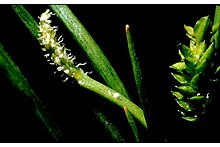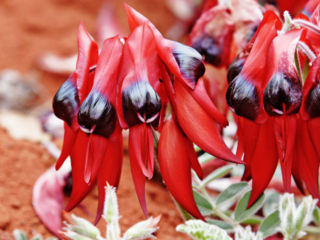
Swainsona formosa, commonly known as Sturt's desert pea or Sturt pea, is a species of flowering plant in the family Fabaceae and is native to all continental states and the Northern Territory of Australia, with the exception of Victoria. It is a prostrate annual or short lived perennial herb with imparipinnate leaves with about 15 elliptic to egg-shaped leaflets with the narrower end towards the base, and racemes of usually red flowers in racemes of 2 to 6.

Epithelantha is a genus of cactus that is native to north-eastern Mexico, and the south-western United States from western Texas to Arizona. There are eight species recognised in the genus Epithelantha. The name Epithelantha refers to the flower position near the apex of the tubercles.

Rauhocereus is a monotypic genus of cacti. Its only species is Rauhocereus riosaniensis, which has nocturnal flowers. It is known from northern Peru.

Samaipaticereus is a monotypic genus of cactus containing the sole species Samaipaticereus corroanus. It is known only from East Andean Bolivia and Peru.

Triglochin is a plant genus in the family Juncaginaceae described by Carl Linnaeus in 1753. It includes 25 known species. It is very nearly cosmopolitan in distribution, with species on every continent except Antarctica. North America has four accepted species, two of which can also be found in Europe: Triglochin palustris and Triglochin maritima. Australia has many more.

Alisma lanceolatum is a species of aquatic plant in the water plantain family known by the common names lanceleaf water plantain and narrow-leaved water plantain. It is widespread across Europe, North Africa and temperate Asia. It is naturalized in Australia, New Zealand, Oregon, California and British Columbia. It is considered a noxious weed in some places.
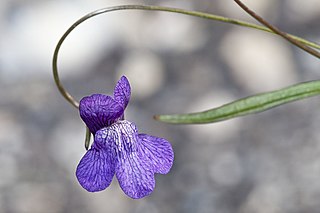
Neogaerrhinum strictum, synonyms including Antirrhinum kelloggii and Neogaerrhinum kelloggii, is a species of flowering plant in the family Plantaginaceae. It is known by the common name Kellogg's snapdragon.

Euphorbia balsamifera is a flowering plant in the spurge family Euphorbiaceae. It is distributed in the Canary Islands and the western Sahara. It is the vegetable symbol of the island of Lanzarote. Euphorbia adenensis has been treated as a subspecies of this species.

Nymphaea nouchali, often known by its synonym Nymphaea stellata, or by common names blue lotus, star lotus, red water lily, dwarf aquarium lily, blue water lily, blue star water lily or manel flower, is a water lily of genus Nymphaea. It is native to southern and eastern parts of Asia, and is the national flower of Bangladesh and Sri Lanka. In Sanskrit it is called utpala. This species is usually considered to include the blue Egyptian lotus N. nouchali var. caerulea. In the past, taxonomic confusion has occurred, with the name Nymphaea nouchali incorrectly applied to Nymphaea pubescens.

Barkleyanthus is a monotypic genus of flowering plants in the aster family, Asteraceae, containing the single species Barkleyanthus salicifolius, a plant formerly classified in the genus Senecio. It is native to North and Central America, where its distribution extends from the southwestern United States to El Salvador. Its common names include willow ragwort, willow groundsel, Barkley's-ragwort, and jarilla.
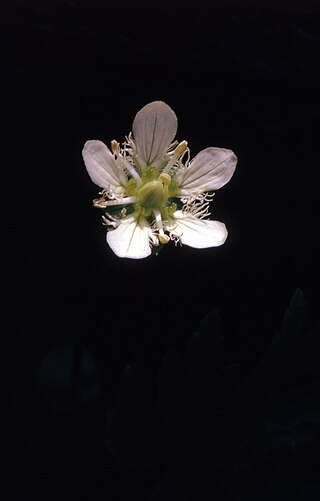
Parnassia fimbriata is a species of flowering plant in the family Celastraceae known by the common name fringed grass of Parnassus. It was first described by Charles Konig. It is native to western North America from Alaska and northwestern Canada to the southern Rocky Mountains, where it is a plant of alpine and subalpine environments, usually in wet areas. Despite the common name, this is not a true grass.

Sagittaria longiloba is a North American species of flowering plant in the water plantain family known by the common name longbarb arrowhead and Gregg arrowhead.
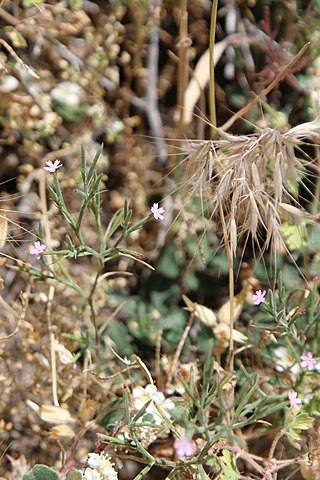
Dianthus nudiflorus, synonym Velezia rigida, is a species of flowering plant in the family Caryophyllaceae. It is native to the Mediterranean Basin countries of Europe and North Africa, and to western and central Asia and Pakistan. It is also present in northern California where it is an introduced species. It is an annual herb growing from a taproot and producing a hairy, glandular, branching green or purplish stem up to 40 centimeters tall. The linear leaves are up to 2 centimeters long. Solitary flowers occur in the leaf axils. Each flower has a very long, cylindrical, ribbed calyx of fused sepals forming the tubular throat of the flower, measuring at least a centimeter in length. At the top of the tube is the flower corolla which has five pink or purplish petals.

Veronica anagallis-aquatica is a species of flowering plant in the family Plantaginaceae known by the common names water speedwell, blue water-speedwell,brook pimpernel.

Barnardia is a small genus of bulbous flowering plants in the family Asparagaceae, subfamily Scilloideae. The genus has two species, one found in the Balearic Islands and north-west Africa, the other in east China, Korea, Japan and adjacent localities. It was suggested in 2012 that the two species were not closely related.

Puschkinia scilloides, commonly known as striped squill or Lebanon squill, is a bulbous perennial, native to Western Asia and the Caucasus.

Duma is a genus of shrubby flowering plants in the family Polygonaceae, subfamily Polygonoideae. The genus was separated from Muehlenbeckia in 2011. The native range of the genus is Australia.

Setiechinopsis is a monotypic genus of cacti. Its only species, Setiechinopsis mirabilis, is native to Argentina.
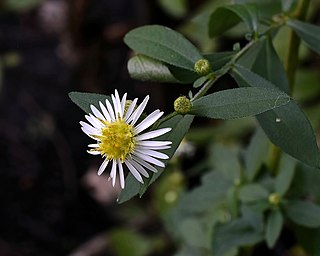
Symphyotrichum ontarionis is a species of flowering plant in the family Asteraceae native to eastern North America. Commonly known as Ontario aster and bottomland aster, it is a perennial, herbaceous plant that may reach heights of 120 centimeters. Each flower head has many tiny florets put together into what appear as one.

Batesanthus pseudopalpus is a species of plant in the Apocynaceae family. It is native to the Republic of the Congo and Gabon. Hendrik J. T. Venter and Rudolf L. Verhoeven, the botanists who first formally described the species, named it after the lobes of its corona which they said resemble the pedipalps of the rain spiders Palystes castaneus and Palystes superciliosus.
